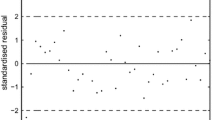Abstract
Influence concepts have an important place in linear regression models and case deletion is a useful method for assessing the influence of single case. The influence measures in the presence of multicollinearity were discussed under the linear regression models when the errors structure is uncorrelated and homoscedastic. In contrast to other article on this subject, we consider the influence measures in ridge regression with autocorrelated errors. Theoretical results are illustrated with a numerical example and a Monte Carlo simulation is conducted to see the effect autocorrelation coefficient, strength of multicollinearity and sample size on leverage points and influential observations.







Similar content being viewed by others
References
Belsley DA, Kuh E, Welsch RE (1980) Regression diagnostics. Wiley, New York
Chatterjee S, Hadi AS (1988) Sensitivity analysis in linear regression. Wiley, New York
Chatterjee S, Hadi AS, Price B (2000) Regression analysis by example, 3rd edn. Wiley, New York
Cook RD, Weisberg S (1982) Residuals and influence in regression. Chapman and Hall, New York
Cook RD (1977) Detection of influential observations in linear regression. Technometrics 19:15–18
Durbin J, Watson GS (1950) Testing for serial correlation in least squares regression I. Biometrica 37(3/4):409–428
Firinguetti L (1989) A simulation study of ridge regression estimators with autocorrelated errors. Commun Statist Simul Comput 18(2):673–702
Haslett J (1999) A simple derivation of deletion diagnostics results for the general linear model with correlated errors. J R Stat Soc Series B 61(3):603–609
Hoerl AE, Kennard RW (1970) Ridge regression: biased estimation for non-orthogonal problems. Technometrics 12(1):55–67
Jahufer A, Jianbao C (2009) Assessing global influential observations in modified ridge regression. Stat Probab Lett 79:513–518
Judge GG, Grifths WE, Hill RC, Lutkepohl H, Lee TC (1985) The theory and practice of econometrics, 2nd edn. Wiley, New York
Judge GG, Hill RC, Griffiths WE, Lutkepohl H, Lee TC (1988) Introduction to the theory and practice of econometrics, 2nd edn. Wiley, New York
Malinvaud E (1968) Statistical methods of econometrics. Rand McNally, Chicago
McDonald GC, Galarneau DI (1975) A Monte Carlo evaluation of some ridge type estimators. J Am Stat Assoc 70:407–416
Myers RH (1990) Classical and modern regression with applications. Duxbury Press, Boston
Özkale MR, Açar Söküt T (2015) Leverages and influential observations in regression model with autocorrelated errors. Commun Stat Theory Methods 44(11):2267–2290
Özkale MR (2013) Influence measures in affine combination type regression. J Appl Stat 40(10):2219–2243
Puterman ML (1988) Leverage and influence in autocorrelated regression models. J R Stat Soc 37(1):76–86
Roy SS, Guria S (2004) Regression diagnostics in an autocorrelated model. Braz J Prob Stat 18:103–112
Shi L, Wang X (1999) Local influence in ridge regression. Comput Stat Data Anal 31:341–353
Steece BM (1986) Regresor space outliers in ridge regression. Commun Stat Theory Methods 15(12):3599–3605
Stemann D, Trenkler G (1993) Leverage and Cochrane–Orcutt estimation in linear regression. Commun Stat Theory Methods 22(5):1315–1333
Trenkler G (1984) On the performance of biased estimators in the linear regression model with correlated or heteroscedastic errors. Commun Stat Theory Methods A 9(12):1247–1259
Walker E, Birch JB (1988) Influence measures in ridge regression. Technometrics 30(2):221–227
Weisberg S (1985) Applied linear regression, 2nd edn. Wiley, New Jersey
Author information
Authors and Affiliations
Corresponding author
Appendix
Appendix
The difference between \(\widehat{b}^{(k)}\) and \(\widehat{b}_{(i)}^{(k)}\) The ARR estimator without the ith observation is
By using Sherman Morrison Woodbury (SMV) Theorem (Myers 1990, p. 459) for the matrix \(\left( Z^{*\prime }Z^{*}-z_{i}^{*\prime }z_{i}^{*}+kI_{p}^{*}\right) ^{-1}\), we get
Then the difference between \(\widehat{b}^{(k)}\) and \(\widehat{b}_{(i)}^{(k)}\) is obtained as
Since \(z_{i}^{*}(\widehat{b}^{(k)}-\widehat{b}_{(i)}^{(k)})=\frac{ l_{i}^{(k)}\widehat{u}_{i}^{(k)*}}{1-l_{i}^{(k)}}\) and
we get the result.
Rights and permissions
About this article
Cite this article
Söküt Açar, T., Özkale, M.R. Influence measures in ridge regression when the error terms follow an Ar(1) process. Comput Stat 31, 879–898 (2016). https://doi.org/10.1007/s00180-015-0615-5
Received:
Accepted:
Published:
Issue Date:
DOI: https://doi.org/10.1007/s00180-015-0615-5




